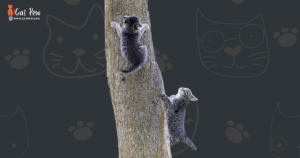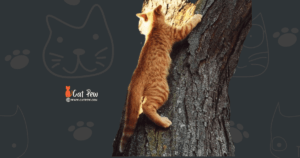Why Was The Cat Afraid Of The Tree?
The cat was afraid of the tree because it saw a snake in it. The cat was terrified of the tree due to the presence of a snake, which triggered its natural fear response.
Cats are instinctively afraid of snakes as a means of self-preservation. The sight of a snake triggers an alarm in their minds, causing them to feel threatened and anxious. In this scenario, the cat’s fear was directed toward the tree because it perceived the snake as a potential danger lurking within its branches.
This fear-induced reaction is a common response among cats, emphasizing their cautious nature and the importance of identifying potential threats in their environment.
Understanding The Fear Response In Cats

The fear response in cats is an instinct that can be triggered by various factors. One possible reason a cat might be afraid of a tree is due to past traumatic experiences or unfamiliarity with their surroundings. Understanding the underlying causes can help create a safe and comfortable environment for our feline friends.
Understanding the Fear Response in Cats Cats are fascinating creatures with complex personalities and behaviors. One behavior that can pique our curiosity is their fear response to certain objects or situations. Have you ever wondered why your cat is afraid of the tree in your backyard? In this post, we will delve into the world of feline fear responses and explore the factors that contribute to their fear of unfamiliar objects.
Cats And Their Instinctual Fear Responses
Cats, just like their wild counterparts, possess instinctual fear responses that have been hardwired into their DNA through years of evolution. These responses serve as a defense mechanism, helping them identify potential threats and ensure their survival. Understanding these instinctual responses can shed light on why cats may feel fear in certain situations. Among the most well-known fear responses in cats is the fight-or-flight response. When faced with a perceived threat, cats may choose to either confront the source of fear or flee from it. This response is triggered by the activation of the cat’s sympathetic nervous system, causing a surge of adrenaline and preparing the cat for action.
Factors That Contribute To Fear Of Unfamiliar Objects
Cats, being creatures of habit, often prefer familiar environments and objects. Anything new or unfamiliar can trigger feelings of fear and anxiety. This is particularly true for objects that deviate from their daily routine, such as a tree suddenly appearing in their previously serene backyard. Several factors contribute to a cat’s fear of unfamiliar objects.
Let’s explore some of these factors:
- Lack of Exposure: Cats rely on environmental familiarity to feel secure. If they have not been exposed to similar objects during their formative years, they may be more prone to fear when encountering something new. A cat that has never come across trees or tall structures before might find the sight of one intimidating.
- Previous negative experiences: Cats have excellent memories, and a past negative experience associated with a particular object can contribute to their fear. If a cat has had a frightful encounter with a tree branch falling, it may develop a fear of trees due to this traumatic experience.
- Sensory sensitivity: Cats possess highly sensitive senses, including acute hearing and sharp vision. Unfamiliar objects may emit sounds or have visual characteristics that feel overwhelming or threatening to their senses, causing fear.
- Lack of control: Cats are known for their independent nature and desire to maintain a sense of control. Unfamiliar objects can disrupt their sense of control, leading to feelings of fear and vulnerability.
By understanding these factors, we can better empathize and support our feline friends when they exhibit fear in the presence of unfamiliar objects. Creating a safe and comforting environment, gradually introducing new objects, and providing positive reinforcement can help alleviate their fear and build their confidence. In conclusion, a cat’s fear of unfamiliar objects is a natural response rooted in their instincts and past experiences. By acknowledging and addressing their fears, we can help them feel more secure and ensure their overall well-being. So the next time you see your cat cowering in fear at the sight of a tree, remember that there may be underlying factors contributing to their fear response.
The Tree As A Terrifying Object To The Cat

The tree stands tall, majestic, and seemingly harmless, but to the cat, it is a terrifying object that stirs fear deep within. Understanding why the cat is afraid of the tree requires delving into not only the physical characteristics of the tree but also how the cat perceives it and the role that past experiences play in shaping their fears.
The Tree’s Physical Characteristics
The tree possesses a myriad of features that can be unsettling to a feline observer. Its towering height casts long shadows that seem to dance in the wind, creating an eerie and mysterious atmosphere. The tree’s branches, gnarled and twisted, create a tangled web that can be perceived as hiding lurking dangers. Its rough bark, abrasive to the touch, can send shivers down the cat’s spine. The tree embodies the unknown, a symbol of potential threats that lie hidden within its depths.
How Cats Perceive The Tree
To the cat, the tree appears as an enigmatic presence in their environment. Cats possess a heightened sense of curiosity, keen observation skills, and an instinctual need to assess their surroundings for potential dangers. They perceive the tree as a structure that seems capable of harboring lurking predators or unseen threats. The rustling leaves and chirping birds perched on its branches further fuel their suspicions, intensifying their fear. For the cat, the tree assumes a dark persona, a mysterious entity that breeds unease.
The Role Of Experience In Fear Of The Tree
Experience plays a pivotal role in shaping the cat’s fear of the tree. Cats rely on their past encounters to make sense of the world around them. If a cat has had a negative experience involving a tree, such as encountering a predator or getting stuck in its branches, it creates a basis for associating the tree with fear and danger. This experience-induced fear can become deeply ingrained, causing the cat to approach any tree with caution and trepidation. Even without any direct negative experiences, the cat may have observed other animals showing fear or distress around trees, reinforcing their fear through indirect experiences.
In conclusion, the tree’s physical characteristics, how cats perceive the tree, and the role of experience all contribute to the cat’s fear of this seemingly innocent object. By understanding these factors, we can begin to empathize with the cat’s perspective and provide reassurance and support to help alleviate their fears.
Examining Possible Threats In The Tree

The fear of trees is not uncommon among cats, and there can be various reasons why a cat might be afraid of a particular tree. In this section, we will explore the potential threats that cats perceive in trees. By understanding these possible dangers, we can help cats overcome their fear and create a safe environment for them. Let’s take a closer look at three key factors that might contribute to a cat’s fear of a tree.
Animals That May Hide In The Tree
One reason why a cat may feel afraid of a tree is the presence of other animals that might be hiding in its branches. When a cat senses the scent or hears the rustling sounds of potential threats, it triggers their survival instincts. So, what kinds of animals could be lurking in the tree? Let’s take a look at a potential list:
| Possible Animals | Threat Level |
|---|---|
| Squirrels | Low/Moderate |
| Birds | Low/Moderate |
| Bees/Wasps | Moderate/High |
| Raccoons | Moderate/High |
While squirrels and birds are generally harmless and avoid conflict with cats, their sudden movements or sharp beaks might startle a cat. On the other hand, the presence of bees, wasps, or raccoons in a tree can pose a direct threat to a cat’s safety, potentially leading to painful stings or aggressive encounters. It is no wonder that cats, being instinctively cautious creatures, may associate trees with these hidden dangers.
The Potential Danger Of Falling Branches
Another possible threat that might make a cat afraid of a tree is the potential danger of falling branches. Trees, especially old or poorly maintained ones, can have dead or weak branches that are at risk of breaking and falling. If a cat has experienced a close call with such a branch in the past, it can leave a lasting impression and reinforce their fear. The fear of being hit by a falling branch is a reasonable concern, as it can lead to injury or even death for a small and vulnerable creature like a cat.
Impact Of Past Negative Experiences
Past negative experiences can significantly impact a cat’s behavior and fears. If a cat has had a traumatic experience involving a tree, such as being trapped or chased by a predator while climbing, it can leave a deep psychological scar. Every time the cat encounters a similar situation, their fear is triggered, and they avoid trees to protect themselves. Negative experiences like these can create a lasting association between trees and danger in a cat’s mind, leading to an automatic fear response.
The Cat’s Natural Predatory Instincts

The cat’s natural predatory instincts kicked in when it sensed movement on the tree, making it afraid and cautious. Its survival instincts prompted it to flee, recognizing potential danger.
How Predatory Instincts Relate To Fear Of Trees
Understanding why the cat in question was afraid of the tree requires delving into its innate predatory instincts. Cats are born hunters, wired to hunt and capture prey. Their predatory instincts are deeply rooted in their DNA, providing them with razor-sharp senses, lightning-fast reflexes, and an unwavering focus when it comes to stalking and pouncing on potential prey. While these instincts serve them well in the wild, they can also play a significant role in their fear of certain objects, such as trees.
The Tree As A Potential Hunting Ground
For cats, trees offer a variety of enticing opportunities when it comes to hunting potential prey. Picture a tree filled with fluttering leaves, twittering birds, or scampering squirrels. The tree’s height provides a vantage point from which a cat can survey its surroundings, pinpointing its prey with precision. However, this same scenario can trigger a complex mix of emotions and instincts in a cat, leading to fear and hesitance.
As a natural predator, the sight and movement of potential prey can send the cat’s heart racing, adrenaline pumping, and pupils dilating. These primal reactions are ingrained in their biology, activating their innate hunting instincts. However, when confronted by a tree, this mix of excitement and anticipation can be overshadowed by a sense of insecurity or vulnerability.
The tree, with its towering height and myriad branches, represents a potential challenge for the cat. It instinctively recognizes that navigating the branches may require more agility and dexterity than it possesses, potentially putting its safety at risk. Fear can stem from the cat’s awareness that it might not have full control over its movements and launching itself towards potential prey may result in losing its footing or becoming entangled in the tree’s branches.
In addition to physical obstacles, a cat’s fear may also arise from encountering unfamiliar scents or noises within the tree. Cats rely heavily on their sense of smell to identify prey, enemies, and potential dangers. The unfamiliar scents emanating from the tree could signal the presence of other animals or even predators, triggering a defensive response. Similarly, rustling leaves or unidentified sounds can create a sense of uncertainty and caution in the cat.
All of these factors contribute to the cat’s fear of trees, as its predatory instincts clash with its need for self-preservation and caution. The cat’s genetic makeup insists on pursuing prey, while its survival instincts urge it to second-guess the safety of certain environments, such as trees.
Overcoming The Fear

When a cat develops a fear of trees, it can be a challenging situation for both the feline and their owner. However, the good news is that with the right approach, a cat can overcome their fear and regain their confidence. In this section, we will explore some practical techniques and strategies to help your cat conquer their fear of trees.
Gradual Desensitization Techniques
One effective method for helping a cat overcome their fear of trees is through gradual desensitization. This technique involves exposing the cat to the feared object or situation in a controlled and gradual manner, allowing them to acclimate to it at their own pace.
Start by introducing the cat to a small potted tree in a familiar and comfortable environment, such as their favorite room. Allow them to approach the tree at their leisure, without any force or pressure. Make sure to keep the experience positive by providing treats, toys, or affection when they show signs of relaxation or curiosity.
Over time, gradually increase the exposure to the tree by moving it closer to a window or placing it outdoors in a secure, confined area. Repeat the process with patience and consistency, ensuring the cat never feels overwhelmed or frightened. This gradual exposure will help them gradually overcome their fear and associate the tree with positive experiences.
The Importance Of Positive Reinforcement
Positive reinforcement plays a vital role in helping a cat overcome their fear of trees. When they exhibit relaxed or curious behavior towards the tree, be sure to provide praise, treats, or playtime to reinforce the positive association.
Consistency is key when using positive reinforcement. Whenever the cat displays any signs of progress or bravery, reward them immediately. This will strengthen their confidence and encourage them to continue overcoming their fear. Similarly, avoid punishing or scolding the cat for showing fear, as this can worsen their anxiety and hinder their progress.
Seeking Professional Help If Needed
In some cases, a cat’s fear of trees may be deeply ingrained or related to past traumatic experiences. If the cat does not show any progress or if their fear becomes excessive, it may be beneficial to seek professional help. A veterinarian or animal behaviorist can provide expert guidance and develop a customized plan to address the cat’s specific fear.
Professional assistance can range from behavior modification techniques to medication, depending on the severity of the fear. Their expertise will ensure a comprehensive approach to help the cat overcome their fear while ensuring their safety and well-being.
Frequently Asked Questions Of Why Was The Cat Afraid Of The Tree
Why Was The Cat Afraid Of The Tree?
The cat was afraid of the tree because it had a bad experience while climbing it. It may have encountered a predator or got stuck on a branch in the past, which caused fear and anxiety. Cats have an instinct to avoid situations that have previously caused them harm, leading to their fear of the tree.
How Can I Help My Cat Overcome Its Fear Of Trees?
To help your cat overcome its fear of trees, start by creating a positive association with them. Gradually introduce your cat to trees in a controlled and safe environment using treats, toys, and praise. Provide your cat with vertical spaces such as cat trees or shelves to climb, giving them a sense of security and control.
Consult with a veterinarian or animal behaviorist for further advice.
Is Fear Of Trees Common In Cats?
Yes, the fear of trees is common in cats. Cats are cautious creatures with a strong instinct for self-preservation. They may display fear or anxiety towards certain objects or environments, such as trees. This fear can be influenced by previous negative experiences, unfamiliarity, or a lack of early exposure to trees.
It is important to understand and address your cat’s fears to ensure their well-being.
Conclusion
While it may seem peculiar, the fear of a cat towards a tree is not uncommon. Understanding the reasons for this apprehension is crucial for pet owners. A combination of factors such as height, unfamiliarity, and potential threats can instill fear in cats.
By acknowledging their fears and providing a sense of safety, cat owners can help their feline friends overcome their trepidation and build a bond of trust. Remember, patience and love are key in helping cats conquer their fear of trees.

Winston
I'm Winston, the author of this feline-focused (Catpew.com) blog . My love for cats goes back to my childhood, when I spent countless hours playing with my family's tabby, Mittens. This furry friend instilled in me a deep appreciation for the unique personalities, playful nature, and unconditional love that cats offer.

